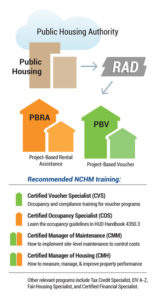“The affordable housing crisis is growing. RAD is part of the solution.”
Former HUD Secretary Julián Castro
The crisis Secretary Castro was referring to is the loss of affordable housing units throughout the country. The loss of 10,000 – 15,000 public housing units each year, coupled with at-risk multifamily “legacy” properties, has created a dangerous shortage of affordable housing units. Over $26 billion in deferred capital repair needs further jeopardizes the supply of affordable housing. To address this threat, HUD created the Rental Assistance Demonstration project (RAD).
RAD allows public housing and at-risk legacy properties to convert to long-term Section 8 Housing Assistance Payment (HAP) contracts. RAD injects otherwise unavailable capital into affordable housing in need of repairs and has proven to be a catalyst for the preservation of affordable housing.
Promising results
 Recently, I joined over 130 other RAD stakeholders participating in the RAD Practice Day in Washington, DC. I was there to learn more about the RAD program, to hear from PHAs that have successfully navigated the process, and to show NCHM’s support for the program. Having spent my entire career in the housing industry — particularly the affordable side — I was excited to hear success stories about the preservation of affordable housing. Hearing how housing authorites in Austin and Greensboro were securing their futures while improving the quality of housing they provide to their communities was very inspiring. I learned that day that the RAD program is a complex, yet promising step towards solving the affordable housing crisis.
Recently, I joined over 130 other RAD stakeholders participating in the RAD Practice Day in Washington, DC. I was there to learn more about the RAD program, to hear from PHAs that have successfully navigated the process, and to show NCHM’s support for the program. Having spent my entire career in the housing industry — particularly the affordable side — I was excited to hear success stories about the preservation of affordable housing. Hearing how housing authorites in Austin and Greensboro were securing their futures while improving the quality of housing they provide to their communities was very inspiring. I learned that day that the RAD program is a complex, yet promising step towards solving the affordable housing crisis.
One reason RAD conversion is effective is because Public Housing properties convert at cost-neutral rents. During the conversion process the current funding source is converted into a HAP contract under the Project-Based Rental Assistance (PBRA) program or the Project Based Voucher program (PBV). Those contracts provide a more secure funding source, but come with new guidelines to follow regarding applicant eligibility, Tenant Selection Plans, waiting lists, leasing requirements, recertifications, terminations, and use of the Enterprise Income Verification (EIV) system. It’s a whole new regulatory environment for those who go through the process.
Training is key
The continued success of RAD hinges upon organizations not only being able to complete the conversion process, but staying compliant with HUD rules and regulations to keep their contracts in good standing over the 20-plus year commitment they made.
The key to staying compliant is training. Those who make the conversion will have to follow new HUD guidelines going forward. NCHM can help! No other organization has a deeper understanding of the complexities of HUD compliance or more training depth than NCHM. Contact us at 800-368-5625 to learn more about Certified Occupancy Specialist (COS), Certified Voucher Specialist (CVS), or our other relevant training programs.
